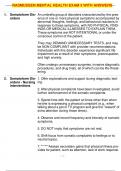RASMUSSEN MENTAL HEALTH EXAM 3 WITH ANSWERS
1. Somatoform Dis- An umbrella group of disorders characterized by the pres-
orders ence of one or more physical symptoms accompanied by
abnormal thoughts, feelings, and behavioral reactions in
response to these symptoms, with NO PHYSICAL FIND-
INGS OR MEDICAL ILLNESSES TO EXPLAIN THEM.
These symptoms are NOT INTENTIONAL or under the
conscious control of the patient.
They may DEMAND UNNECESSARY TESTS, and may
be NON-COMPLIANT with provider recommendations.
Individuals with this disorder experience significant life
impairment as a result of their symptoms, preoccupation,
and high anxiety.
Often undergo unnecessary surgeries, invasive diagnostic
procedures, and drug trials, all of which can be life-threat-
ening.
2. Somatoform Dis- 1. Offer explanations and support during diagnostic test-
orders - Nursing ing.
interventions
2. After physical complaints have been investigated, avoid
further reinforcement of the somatic complaints.
3. Spend time with the patient at times other than when
he/she is expressing a physical complaint (e.g., when
talking about a pet or TV program and give the "reward" of
extra attention during those times).
4. Observe and record frequency and intensity of somatic
symptoms.
5. DO NOT imply that symptoms are not real.
6. Shift focus from somatic complaints to feelings or to
neutral topics.
7. ******Assess secondary gains that physical illness pro-
vides for patient, such as attention, lack of work responsi-
, RASMUSSEN MENTAL HEALTH EXAM 3 WITH ANSWERS
bility, or guilt of a spouse causing them to stay rather than
leave the patient.
8. Use straightforward approach to patient exhibiting resis-
tance or covert anger.
9. Have patient direct all requests to a designated nurse
or clinician.
10. Show concern for patient, but avoid fostering depen-
dency needs.
11. Reinforce patient's strengths and problem-solving abil-
ities.
12. Teach assertive communication skills and techniques.
13. Teach patient stress reduction techniques, such as
meditation, relaxation, and mild physical exercise.
3. Important thing When patients complain of physical symptoms, TAKE THE
to remember re- SYMPTOMS SERIOUSLY. Even if a medical explanation
garding the as- is not found understandable, the symptoms are real and
sessment of a distressing to the patient.
patient with so-
matoform disor- Working with people who have somatic symptom disor-
der ders can be frustrating, and you and other staff may find
yourself avoiding interaction with them. However, when
people feel they are receiving care and attention, the inten-
sity of symptoms tends to diminish. As the symptoms are
alleviated and **RAPPORT IS ESTABLISHED, it becomes
easier to address emotional issues.
4. Secondary Gains Benefits that a person might be receiving from the symp-
toms they are having.
Example: the patient is not able to perform the usual family,
work, and social functions, and receives extra attention
from loved ones.
, RASMUSSEN MENTAL HEALTH EXAM 3 WITH ANSWERS
If a patient derives personal benefit from the symptoms,
relinquishing the symptoms is more difficult.
5. Hypochondria- Preoccupied with having or eventually developing a seri-
sis (Illness ous illness. Patients with this disorder may or may not pre-
Anxiety sent with somatic symptoms, and if they do, the symptoms
Disorder) are usually mild.
What they do exhibit is a high level of anxiety and alarm
about their health lasting at least 6 months, and may either
excessively check for problems or avoid medical care. It is
important to consider other possible diagnoses such as
anxiety disorders.
They are more alarmed by the potential implications of
any disorder than with the disorder itself, and are alarmed
with any new bodily sensations. Patients can misinterpret
normal physical sensations such as sweating, abdominal
cramping, or awareness of heartbeat as indicative of dis-
ease.
6. Conversion Dis- Disorder that presents with one or more symptoms of
order impaired motor or sensory function. The deficit causes
significant distress to the patient and impaired social or
occupational functioning.
Symptoms include weakness or paralysis, abnormal
movement, swallowing or speech difficulties, seizures or
attacks, sensory loss or anesthesia, or symptoms involv-
ing the senses (blindness or loss of smell).
7. Nursing Interven- Use a straight forward approach
tions for Conver-
sion Disorder Be supportive, yet ASSERTIVE with them
Pt independence is IMPORTANT, they need to be able to
take care of THEMSELVES. Don't do everything for them!
8.
, RASMUSSEN MENTAL HEALTH EXAM 3 WITH ANSWERS
Dissociative Dis- A disturbance in the normally well-integrated continuum of
orders consciousness, memory, identity, and perception.
Dissociation is an unconscious defense mechanism to
protect the individual against overwhelming anxiety RE-
LATED TO PAST TRAUMA, and ranges from minor to
severe in presentation.
Patients with dissociative disorders have intact reality test-
ing, meaning they are not delusional or hallucinating. Peo-
ple with these disorders routinely experience significant
emotional pain and struggle with overall functioning and
safety.
9. Dissociative Often associated with dissociative amnesia, which is am-
Fugue nesia related to a traumatic accident. Fugue is when the
patient flees from their normal life to another location and
starts a new life.
Gradually over time, memories of the original life may
be triggered. Patients can become confused and embar-
rassed when the amnesia subsides and memory returns.
10. Interventions for 1. Ensure patient safety by providing safe, protected envi-
Dissociative Dis- ronment and frequent observation.
orders
2. Provide non-demanding, simple routine.
3. Confirm identity of patient and orientation to time and
place.
4. Encourage patient to do things for self and make deci-
sions about routine tasks.
5. Assist with other decision making until memory im-
proves.
6. Support patient during exploration of feelings surround-
ing the stressful event.




